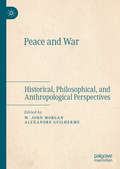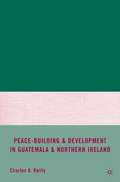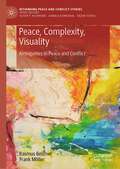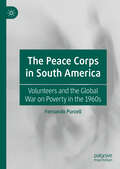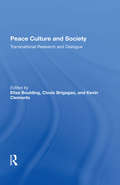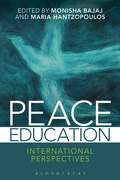- Table View
- List View
Peace and War: Historical, Philosophical, and Anthropological Perspectives
by W. John Morgan Alexandre GuilhermePeace and War: Historical, Philosophical, and Anthropological Perspectives is an accessible, higher-level critical discussion of philosophical commentaries on the nature of peace and war. It introduces and analyses various philosophies of peace and war, and their continuing theoretical and practical relevance for peace studies and conflict resolution. Using a combination of both historical and contemporary philosophical perspectives, the book is at once eclectic in its approach and broad in its inquiry of these enduring phenomena of human existence.
Peace and War on the Anglo-Cherokee Frontier, 1756–63
by J. OliphantWhile the Seven Years War pushed London towards a protective Native American policy, outcomes were determined by men on the spot. The savage Anglo-Cherokee war was resolved by Cherokee headmen willing to accept a dignified peace; and by the sympathy of the very man sent to crush them. Colonel James Grant forced his treaty upon South Carolina, demonstrated the value of imperial frontier management and started some Carolinians on the road to revolution.
Peace as Governance: Power-Sharing, Armed Groups and Contemporary Peace Negotiations (Rethinking Peace and Conflict Studies)
by C. SriramA critical study of incentives commonly used to induce non-state armed groups to engage in peace negotiations. Offers a closer analysis of these incentives, which offer such groups a place or a stake in governance, suggesting that not only are they frequently ineffective, but that they can have unintended and dangerous side effects.
The Peace Brokers: Mediators in the Arab-Israeli Conflict, 1948-1979
by Saadia TouvalFrom Israel's establishment as a state to the Egyptian-Israeli peace treaty, this work analyzes the role of third-party mediators of the Arab-Israeli dispute. What interests prompted the mediators to undertake their efforts? What effect did their intervention have on regional and global power struggles? Did the mediators actually make any difference? In a thorough treatment of the struggle for a negotiated peace, Saadia Touval answers these questions and tests his answers against the existing theories of international relations. Including a discussion of both United States and United Nations attempts at mediation, and providing a detailed picture of American-Israeli relations, he maintains that successful mediators do not have to be impartial. Drawing on official documents, memoirs, and other sources, this book discusses the mediation efforts of Count Folke Bernadotte; Ralph Bunche; the United Nations Palestine Conciliation Commission; President Eisenhower's emissary, Robert Anderson; Gunnar Jarring; the 1971 mission of the African heads of state; and Secretaries of State William Rogers and Henry Kissinger. Finally the author analyzes President Jimmy Carter's mediation, which led to the Camp David accords and the signing of the Egyptian-Israeli peace treaty. Since 1948 various powers have sought to protect their own interests by active assistance to one party or another in the Arab-Israeli struggle. This book shows how those countries and institutions that have attempted to mediate the conflict have also acted out of self-interest.
The Peace Brokers: Mediators in the Arab-Israeli Conflict, 1948-1979
by Saadia TouvalFrom Israel's establishment as a state to the Egyptian-Israeli peace treaty, this work analyzes the role of third-party mediators of the Arab-Israeli dispute. What interests prompted the mediators to undertake their efforts? What effect did their intervention have on regional and global power struggles? Did the mediators actually make any difference? In a thorough treatment of the struggle for a negotiated peace, Saadia Touval answers these questions and tests his answers against the existing theories of international relations. Including a discussion of both United States and United Nations attempts at mediation, and providing a detailed picture of American-Israeli relations, he maintains that successful mediators do not have to be impartial. Drawing on official documents, memoirs, and other sources, this book discusses the mediation efforts of Count Folke Bernadotte; Ralph Bunche; the United Nations Palestine Conciliation Commission; President Eisenhower's emissary, Robert Anderson; Gunnar Jarring; the 1971 mission of the African heads of state; and Secretaries of State William Rogers and Henry Kissinger. Finally the author analyzes President Jimmy Carter's mediation, which led to the Camp David accords and the signing of the Egyptian-Israeli peace treaty. Since 1948 various powers have sought to protect their own interests by active assistance to one party or another in the Arab-Israeli struggle. This book shows how those countries and institutions that have attempted to mediate the conflict have also acted out of self-interest.
Peace-Building and Development in Guatemala and Northern Ireland
by C. ReillyThis book analyzes the implementation of peace processes in Northern Ireland and Guatemala, with emphasis on the role of mid-level civil society and religious organizations, or "the voluntary sector." Both countries interrupted years of conflict, signed peace accords in 1998 and 1996 respectively, and still struggle to make them work. Despite very different economic development levels, both countries have colonial legacies, deep cultural divisions, and engaged diaspora. They grapple with violence, poverty and inequitable distribution of wealth and power. While religious differences are a backdrop to violence and reconciliation in both cases, insecurity and inequity are the root cause and consequence of these conflicts. The book summarizes lessons learned and makes policy recommendations for more civil post-conflict societies, arguing that similar dynamics fuel sustainable peace-building and authentic development.
Peace-building in Israel and Palestine: Social Psychology and Grassroots Initiatives
by J. ChaitinThis book presents an overview of psycho-social research on the Israeli-Palestinian conflict, presents and analyzes people-to-people activities in the region, and offers new conceptualizations for Israeli-Palestinian co-creation of a grassroots peace and social justice processes.
Peace Building Through Women’s Health: Psychoanalytic, Sociopsychological, and Community Perspectives on the Israeli-Palestinian Conflict (Psychoanalytic Inquiry Book Series)
by Norbert GoldfieldThis book is an examination of the Israeli-Palestinian conflict through psychoanalytic, sociopsychological, and nationalistic lenses, highlighting the successes and the hurdles faced by one organization, Healing Across the Divides (HATD), in its mission to measurably improve health in marginalized populations of both Israelis and Palestinians. Peace Building through Women’s Health begins with a summary of the "peace building through health" field and a psychoanalytic, sociopsychological examination of the Israeli-Palestinian conflict. After a series of informative case studies, the book concludes with an analysis of how this organization has evolved its "peace building through health" approach over the fifteen years since its founding. Working with community groups, HATD has measurably improved the lives of more than 200,000 marginalized Israelis and Palestinians. In the process, it also improves the effectiveness of the community group grantees, by offering experienced management consulting and by requiring rigorous ongoing self-assessment on the part of the groups. IHATD hopes that, in the long term, some of the community leaders it supports will be tomorrow’s political leaders. As these leaders strengthen their own capabilities, they will be able to increasingly contribute to securing peace in one of the longest running conflicts in the world today. Peace Building through Women’s Health will be invaluable to public and mental health professionals interested in international health, peace and conflict studies, and conflict resolution.
Peace Building Through Women’s Health: Psychoanalytic, Sociopsychological, and Community Perspectives on the Israeli-Palestinian Conflict (Psychoanalytic Inquiry Book Series)
by Norbert GoldfieldThis book is an examination of the Israeli-Palestinian conflict through psychoanalytic, sociopsychological, and nationalistic lenses, highlighting the successes and the hurdles faced by one organization, Healing Across the Divides (HATD), in its mission to measurably improve health in marginalized populations of both Israelis and Palestinians. Peace Building through Women’s Health begins with a summary of the "peace building through health" field and a psychoanalytic, sociopsychological examination of the Israeli-Palestinian conflict. After a series of informative case studies, the book concludes with an analysis of how this organization has evolved its "peace building through health" approach over the fifteen years since its founding. Working with community groups, HATD has measurably improved the lives of more than 200,000 marginalized Israelis and Palestinians. In the process, it also improves the effectiveness of the community group grantees, by offering experienced management consulting and by requiring rigorous ongoing self-assessment on the part of the groups. IHATD hopes that, in the long term, some of the community leaders it supports will be tomorrow’s political leaders. As these leaders strengthen their own capabilities, they will be able to increasingly contribute to securing peace in one of the longest running conflicts in the world today. Peace Building through Women’s Health will be invaluable to public and mental health professionals interested in international health, peace and conflict studies, and conflict resolution.
The Peace Business: Money and Power in the Palestine-Israel Conflict (Library of Modern Middle East Studies)
by Markus BouillonMarkus Bouillon's book makes an important and original contribution to the literature on the Middle East peace process. It is based on extensive and imaginative research and it is packed with new and fascinating material. Bouillon places the behaviour of the elites under an uncompromising lens. His work serves as a useful corrective to the conventional wisdom by highlighting the negative effects of the peace process for all but the elites in Israel, Jordan, and the Palestinian territories.Avi Shlaim, Oxford University."The first full-length, authoritative account of the various dimensions of business in the context of Arab-Israeli “peace”. … an empirically dense and nuanced analysis"James Piscatori, Oxford University
Peace by Design
by Mardelle McCuskey ShepleyWe live in an era in which designers will make an essential and critical contribution to the health and success of humanity. Design can promote healing in healthcare environments, contribute to good mental health, reduce gun violence, and positively impact health and racial equity, all of which contribute to providing a more peaceful world.The primary focus of this book is to inspire young designers, academics, and practitioners to achieve their maximum societal contribution. It also supports experienced designers seeking reaffirmation of their social goals. To provide a foundation, the first chapter discusses the definition of design and design thinking and evidence regarding the direct and indirect contributions of design to peace. The subsequent chapters address peace endeavors at six scales of the physical environment: sustainable and equitable design, landscape architecture, architecture, interior design, industrial design, and graphic design. Additionally, nine short cameos are provided by contributors from various disciplines, who provide their favorite examples of “peace projects.” Peace can be manifested at multiple levels: world-wide, neighborhood and community, familial, or individual, and the various authors discuss portions from this spectrum. They broadly endorse disciplinary entanglements as a means of addressing societal and sustainability challenges and celebrate the impact of collaboration.This book is essential reading for students and practitioners representing all fields of design, including graphic design, industrial design, interior design, architecture, landscape architecture, and urban design.
Peace by Design
We live in an era in which designers will make an essential and critical contribution to the health and success of humanity. Design can promote healing in healthcare environments, contribute to good mental health, reduce gun violence, and positively impact health and racial equity, all of which contribute to providing a more peaceful world.The primary focus of this book is to inspire young designers, academics, and practitioners to achieve their maximum societal contribution. It also supports experienced designers seeking reaffirmation of their social goals. To provide a foundation, the first chapter discusses the definition of design and design thinking and evidence regarding the direct and indirect contributions of design to peace. The subsequent chapters address peace endeavors at six scales of the physical environment: sustainable and equitable design, landscape architecture, architecture, interior design, industrial design, and graphic design. Additionally, nine short cameos are provided by contributors from various disciplines, who provide their favorite examples of “peace projects.” Peace can be manifested at multiple levels: world-wide, neighborhood and community, familial, or individual, and the various authors discuss portions from this spectrum. They broadly endorse disciplinary entanglements as a means of addressing societal and sustainability challenges and celebrate the impact of collaboration.This book is essential reading for students and practitioners representing all fields of design, including graphic design, industrial design, interior design, architecture, landscape architecture, and urban design.
Peace by Peaceful Means: Peace and Conflict, Development and Civilization (PDF)
by Professor Johan GaltungJohan Galtung, one of the founders of modern peace studies, provides a wide-ranging panorama of the ideas, theories and assumptions on which the study of peace is based. The book is organized in four parts, each examining the one of the four major theoretical approaches to peace. The first part covers peace theory, exploring the epistemological assumptions of peace. In Part Two conflict theory is examined with an exploration of nonviolent and creative handling of conflict. Developmental theory is discussed in Part Three, exploring structural violence, particularly in the economic field, together with a consideration of the ways of overcoming that violence. The fourth part is devoted to civilization theory. This involves an exploration of cultural violence focusing on the deeper aspects of cultures. Finally, the threads of these four approaches are drawn together with a focus on peace action - peace by peaceful means.
Peace by Peaceful Means: Peace and Conflict, Development and Civilization
by Professor Johan GaltungJohan Galtung, one of the founders of modern peace studies, provides a wide-ranging panorama of the ideas, theories and assumptions on which the study of peace is based. The book is organized in four parts, each examining the one of the four major theoretical approaches to peace. The first part covers peace theory, exploring the epistemological assumptions of peace. In Part Two conflict theory is examined with an exploration of nonviolent and creative handling of conflict. Developmental theory is discussed in Part Three, exploring structural violence, particularly in the economic field, together with a consideration of the ways of overcoming that violence. The fourth part is devoted to civilization theory. This involves an exploration of cultural violence focusing on the deeper aspects of cultures. Finally, the threads of these four approaches are drawn together with a focus on peace action - peace by peaceful means.
Peace, Complexity, Visuality: Ambiguities in Peace and Conflict (Rethinking Peace and Conflict Studies)
by Rasmus Bellmer Frank MöllerThis book argues that we can capitalize on the tolerance of ambiguity-enhancing potentialities inherent in visual images – their non-coherence – and thus increase our capability of tolerating ambiguities. Studying international relations equals studying ambiguity. The international system is complex, and where there is complexity, there is also ambiguity. Crucially, in a world saturated not only with ambiguities but also with visual images, it is mandatory to think ambiguity and visuality together. The authors analyze the constructive and peaceful potentialities of ambiguities through an exploration of journalistic imagery in the context of post-war Bosnia and post-siege Sarajevo.The book is a theoretically sophisticated, yet accessible, and politically relevant exercise in inter-disciplinary thinking, uniquely combining literature on complexity, ambiguity and visuality thus offering important readings for international relations, peace and conflict research, and security studies.
The Peace Continuum: What It Is and How to Study It (Studies in Strategic Peacebuilding)
by Christian Davenport Erik Melander Patrick M. ReganThe idea of studying peace has gained considerable traction in the past few years after languishing in the shadows of conflict for decades but how should it be studied? The Peace Continuum offers a parallax view of how we think about peace and the complexities that surround the concept (i.e., the book explores the topic from different positions at the same time). Toward this end, we review existing literature and provide insights into how peace should be conceptualized - particularly as something more interesting than the absence of conflict. We provide an approach that can help scholars overcome what we see as the initial shock that comes with unpacking the 'zero' in the war-peace model of conflict studies. Additionally, we provide a framework for understanding how peace and conflict have/have not been related to one another in the literature. To reveal how the Peace Continuum could be applied, we put forward three alternative ways that peace could be studied. With this approach, the book is less trying to control the emerging peace research agenda than it is trying to assist in/encourage thinking about the topic that we all have some opinion on but that has yet to be measured and analyzed in a way comparable to political conflict and violence. Indeed, we attempt to help facilitate a veritable explosion of approaches and efforts to study peace.
PEACE CONTINUUM SSP C: What It Is and How to Study It (Studies in Strategic Peacebuilding)
by Christian Davenport Patrick M. Regan Erik MelanderThe idea of studying peace has gained considerable traction in the past few years after languishing in the shadows of conflict for decades but how should it be studied? The Peace Continuum offers a parallax view of how we think about peace and the complexities that surround the concept (i.e., the book explores the topic from different positions at the same time). Toward this end, we review existing literature and provide insights into how peace should be conceptualized - particularly as something more interesting than the absence of conflict. We provide an approach that can help scholars overcome what we see as the initial shock that comes with unpacking the 'zero' in the war-peace model of conflict studies. Additionally, we provide a framework for understanding how peace and conflict have/have not been related to one another in the literature. To reveal how the Peace Continuum could be applied, we put forward three alternative ways that peace could be studied. With this approach, the book is less trying to control the emerging peace research agenda than it is trying to assist in/encourage thinking about the topic that we all have some opinion on but that has yet to be measured and analyzed in a way comparable to political conflict and violence. Indeed, we attempt to help facilitate a veritable explosion of approaches and efforts to study peace.
The Peace Corps in South America: Volunteers and the Global War on Poverty in the 1960s
by Fernando PurcellIn the 1960s, twenty-thousand young Americans landed in South America to serve as Peace Corps volunteers. The program was hailed by President John F. Kennedy and by volunteers themselves as an exceptional initiative to end global poverty. In practice, it was another front for fighting the Cold War and promoting American interests in the Global South. This book examines how this ideological project played out on the ground as volunteers encountered a range of local actors and agencies engaged in anti-poverty efforts of their own. As they negotiated the complexities of community intervention, these volunteers faced conflicts and frustrations, struggled to adapt, and gradually transformed the Peace Corps of the 1960s into a truly global, decentralized institution. Drawing on letters, diaries, reports, and newsletters created by volunteers themselves, Fernando Purcell shows how their experiences offer an invaluable perspective on local manifestations of the global Cold War.
Peace Culture And Society: Transnational Research And Dialogue
by Elise Boulding Clovis Brigagao Kevin Clements"1989 certainly represents one of those moments. yet, when IPRA held its 12th General Conference in August 1988, few of the participants imagined that within the space of 13 months popular social movements would topple socialist regimes in Poland, Czechoslovakia, Hungary and the German Democratic Republic.Nobody imagined the Berlin wall or the wire fence between Hungary and Austria being dismantled. Even fewer contemplated the overthrow of the Ceaucescu regime in Rumania, pluralistic politics in Bulgaria, a single German economy or a reunited Germany."
Peace Culture And Society: Transnational Research And Dialogue
by Elise Boulding Clovis Brigagao Kevin Clements"1989 certainly represents one of those moments. yet, when IPRA held its 12th General Conference in August 1988, few of the participants imagined that within the space of 13 months popular social movements would topple socialist regimes in Poland, Czechoslovakia, Hungary and the German Democratic Republic.Nobody imagined the Berlin wall or the wire fence between Hungary and Austria being dismantled. Even fewer contemplated the overthrow of the Ceaucescu regime in Rumania, pluralistic politics in Bulgaria, a single German economy or a reunited Germany."
Peace, Defence and Economic Analysis: Proceedings of a Conference held in Stockholm jointly by the International Economic Association and the Stockholm International Peace Research Institute (International Economic Association Series)
by Frank Blackaby Christain SchmidtPeace, Development and Security in the Caribbean
by Anthony T. Bryan Edward J. Greene Timothy M. ShawA collection of interdisciplinary essays which attempt to analyze cultural, economic, political and social diversities and resources from alternative regional and international viewpoints. The contributors are scholars familiar with the intricacies and idiosyncracies of Caribbean development.
Peace, Discontent and Constitutional Law: Challenges to Constitutional Order and Democracy (Comparative Constitutional Change)
by Martin BelovThis book offers a multi-discursive analysis of the constitutional foundations for peaceful coexistence, the constitutional background for discontent and the impact of discontent, and the consequences of conflict and revolution on the constitutional order of a democratic society which may lead to its implosion. It explores the capacity of the constitutional order to serve as a reliable framework for peaceful co-existence while allowing for reasonable and legitimate discontent. It outlines the main factors contributing to rising pressure on constitutional order which may produce an implosion of constitutionalism and constitutional democracy as we have come to know it. The collection presents a wide range of views on the ongoing implosion of the liberal-democratic constitutional consensus which predetermined the constitutional axiology, the institutional design, the constitutional mythology and the functioning of the constitutional orders since the last decades of the 20th century. The constitutional perspective is supplemented with perspectives from financial, EU, labour and social security law, administrative law, migration and religious law. Liberal viewpoints encounter radical democratic and critical legal viewpoints. The work thus allows for a plurality of viewpoints, theoretical preferences and thematic discourses offering a pluralist scientific account of the key challenges to peaceful coexistence within the current constitutional framework. The book provides a valuable resource for academics, researchers and policymakers working in the areas of constitutional law and politics.
Peace, Discontent and Constitutional Law: Challenges to Constitutional Order and Democracy (Comparative Constitutional Change)
by Martin BelovThis book offers a multi-discursive analysis of the constitutional foundations for peaceful coexistence, the constitutional background for discontent and the impact of discontent, and the consequences of conflict and revolution on the constitutional order of a democratic society which may lead to its implosion. It explores the capacity of the constitutional order to serve as a reliable framework for peaceful co-existence while allowing for reasonable and legitimate discontent. It outlines the main factors contributing to rising pressure on constitutional order which may produce an implosion of constitutionalism and constitutional democracy as we have come to know it. The collection presents a wide range of views on the ongoing implosion of the liberal-democratic constitutional consensus which predetermined the constitutional axiology, the institutional design, the constitutional mythology and the functioning of the constitutional orders since the last decades of the 20th century. The constitutional perspective is supplemented with perspectives from financial, EU, labour and social security law, administrative law, migration and religious law. Liberal viewpoints encounter radical democratic and critical legal viewpoints. The work thus allows for a plurality of viewpoints, theoretical preferences and thematic discourses offering a pluralist scientific account of the key challenges to peaceful coexistence within the current constitutional framework. The book provides a valuable resource for academics, researchers and policymakers working in the areas of constitutional law and politics.
Peace Education: International Perspectives
by Monisha Bajaj Maria Hantzopoulos'Honorable Mention' 2017 PROSE Award - Education PracticeBringing together the voices of scholars and practitioners on challenges and possibilities of implementing peace education in diverse global sites, this book addresses key questions for students seeking to deepen their understanding of the field. The book not only highlights ground-breaking and rich qualitative studies from around the globe, but also analyses the limits and possibilities of peace education in diverse contexts of conflict and post-conflict societies. Contributing authors address how educators and learners can make meaning of international peace education efforts, how various forms of peace and violence interact in and around schools, and how the field of peace education has evolved and grown over the past four decades.
